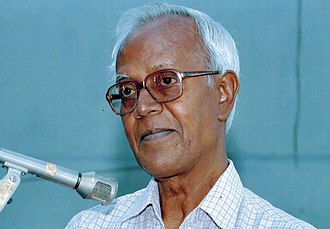"The law gives citizens the right to erect statues on their own private property. The only restriction is that the idol should not bring any conflicts between two communities or in such a way as to hurt the sentiments of a particular community," the court ruled.
Published Nov 27, 2024 | 12:02 AM ⚊ Updated Nov 27, 2024 | 12:02 AM

Fr Stan Swamy in 2010. He was India's oldest person to be accused of terrorism. (WIkimedia Commons)
Dismissing the Tamil Nadu government’s objections, the Madras High Court has allowed an activist to install a memorial pillar for the late Jesuit priest and tribal welfare activist Father Stan Swamy on his property.
Justice M Dandapani of the high court ruled that the state cannot prevent an individual from erecting a memorial on his private property.
”Father Stan Swamy has done many programs for the welfare of tribals. Moreover, as a general principle, the law gives citizens the right to erect statues on their own private property. The only restriction is that the idol should not bring any conflicts between two communities or in such a way as to hurt the sentiments of a particular community,” the court said recently.
The high court clarified that there was no legal bar to allow the installation of a statue on private patta land. The court also said that Sethia (the petitioner) would have to bear all the expenses of constructing the Stan Swamy memorial on his land.
Activist Piyush Sethia moved the high court in 2021 through Advocate Dr V Suresh after the Nallampalli taluka tehsildar prevented him from setting up the memorial on his property in the Dharmapuri district.
The petitioner was planning a stone pillar with Fr Stan Swamy’s picture since the late Jesuit priest was his mentor. However, on 16 June 2021, the authorities rejected Sethia’s request “for reasons best known to them”, the high court noted.
The respondents argued in the court that the stone tablet pertained to a person, “who had been related to the Naxals and Maoists, and it would hamper the law and order of the area if such erection is permitted. Hence, he (tehsildar) seriously objected to the said erection and prayed for dismissal of this writ petition”, the court pointed out in its order.
It was also argued that the statue was planned at a sensitive place and that installing it would lead to communal clashes.
Setting aside the objections, the court granted Sethia the “liberty to erect the stone pillar of Fr. Stan Swamy on his private patta land in Nekkundi Village, Nallampallai Taluk, Dharmapuri District”.
“It is made clear that erecting the said stone pillar at the aforesaid petitioner’s property shall not cause any hindrance to the public at large,” the court ruled.
Stanislaus Lourduswamy, popularly known as Fr Stan Swamy, was born at Viragalur in Tiruchirappalli. The National Investigation Agency arrested him on 8 October 2020 under the Unlawful Activities (Prevention) Act, accusing him of playing a role in the 2018 Bhima Koregaon violence and links to Maoists.
Fr Stan Swamy’s repeated pleas for bail on medical grounds were rejected though he was suffering from Parkinson’s disease. He was denied proper care in Taloja Central Jail, where his health deteriorated. He died while undergoing treatment at the Holy Family Hospital in Mumbai on 5 Mumbai 2021, aged 84.
The tribal welfare activist was also India’s oldest person to be accused of terrorism.
His arrest and subsequent death, allegedly due to the denial of proper medical care, including a straw and sipper to feed himself, grabbed international attention.
In December 2022, The Washington Post quoted a report by Arsenal Consulting, a Massachusetts-based digital forensics firm, “that a hacker infiltrated his )Fr Stan Swamy’s) device and planted evidence.
“The analysis is more proof that Swamy and his co-defendants were framed in a case that exemplifies the Indian government’s crackdown against civil society and prominent critics,” The Post quoted the defence team.
In February 2022, the UN Working Group on Arbitrary Detention declared Swamy’s imprisonment arbitrary and his death “utterly preventable”.
(Edited by Majnu Babu).
